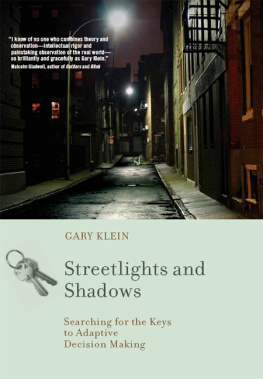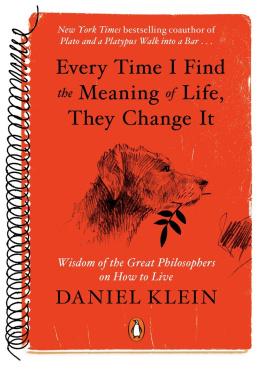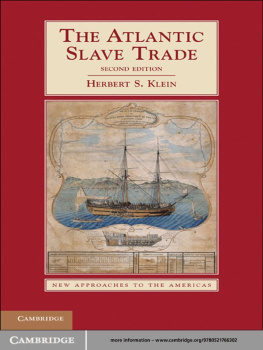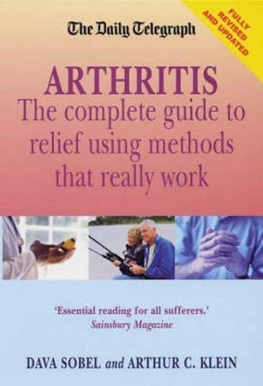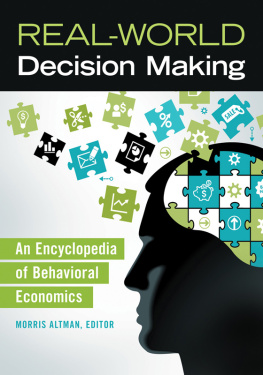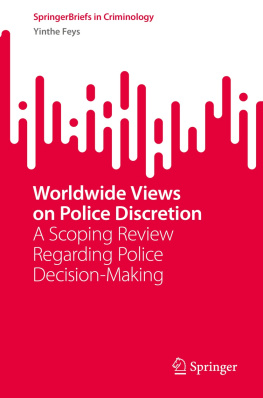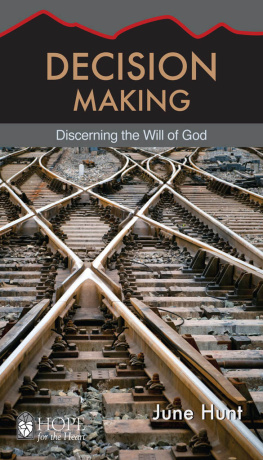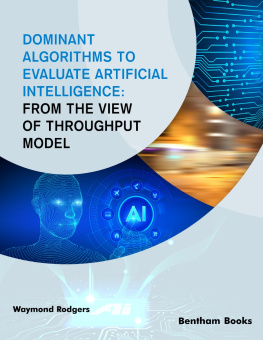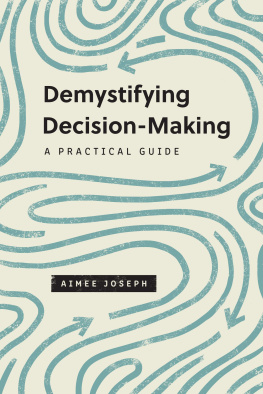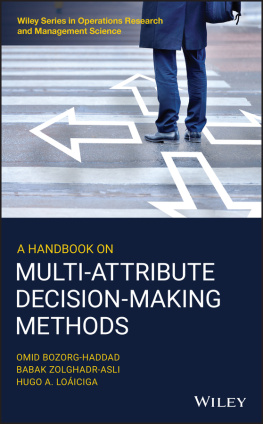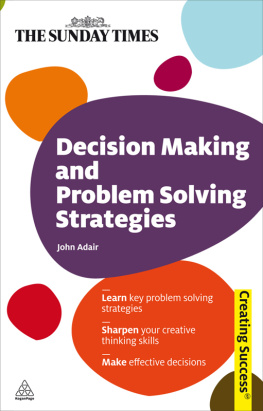Streetlights and Shadows
Streetlights and Shadows
Searching for the Keys to Adaptive Decision Making
Gary Klein
A Bradford Book
The MIT Press
Cambridge, Massachusetts
London, England
2009 Massachusetts Institute of Technology
All rights reserved. No part of this book may be reproduced in any form by any electronic or mechanical means (including photocopying, recording, or information storage and retrieval) without permission in writing from the publisher.
MIT Press books may be purchased at special quantity discounts for business or sales promotional use. For information, email special_sales@mitpress.mit.edu or write to Special Sales Department, MIT Press, 55 Hayward Street, Cambridge, MA 02142.
Set in Palatino on 3B2 by Asco Typesetters, Hong Kong. Printed and bound in the United States of America.
Library of Congress Cataloging-in-Publication Data
Klein, Gary
Streetlights and shadows : searching for the keys to adaptive decision making / Gary Klein.
p. cm.
A Bradford Book.
Includes bibliographical references and index.
ISBN 978-0-262-01339-0 (hardcover : alk. paper)
1. Decision making. 2. Problem solving. I. Title.
BF448.K54 2009
153.83dc22
2009007501
10 9 8 7 6 5 4 3 2 1
to Helen, Devorah, and Rebecca
Contents
List of Examples
| 1 | Ten Surprises about How We Handle Ambiguous Situations |
| Part I | Making Decisions |
| 2 | A Passion for Procedures |
| 3 | Seeing the Invisible |
| 4 | How Biased Is Our Thinking? |
| 5 | Intuition versus Analysis |
| 6 | Blending Intuition and Analysis to Make Rapid Decisions |
| 7 | Experts and Errors |
| 8 | Automating Decisions |
| Part II | Making Sense of Situations |
| 9 | More Is Less |
| 10 | When Patience Is a Vice |
| 11 | The Limits of Feedback |
| 12 | Correcting the Dots |
| 13 | Do We Think Like Computers? |
| Part III | Adapting |
| 14 | Moving Targets |
| 15 | The Risks of Risk Management |
| 16 | The Cognitive Wavelength |
| 17 | Unlearning |
| Part IV | Finishing |
| 18 | Reclaiming Our Minds |
| 19 | Getting Found |
Acknowledgments
Notes
Bibliography
Index
List of Examples
| A flying brick 19 |
| The hijack procedures 20 |
| The high road and the low road 22 |
| The bubble 26 |
| Sailsmanship 37 |
| The fall guy 38 |
| Catching criminals while they are sleeping 40 |
| Tracking the customers 41 |
| Detection work 42 |
| The hidden hotel 45 |
| How to lie to your toaster 57 |
| The gaze heuristic 59 |
| Panning the pundits 68 |
| Location, location, and... dislocation 74 |
| The unsinkable hedge fund 75 |
| Deliberation without attention 76 |
| Who is leading the race? 77 |
| Pushing the fire out 88 |
| Good to the last drop 89 |
| Miracle on the Hudson 91 |
| ApartMental simulation 97 |
| Horse sense 102 |
| Outsmarting diabetes 107 |
| Racking and stacking 121 |
| The failure to detect the attack on Pearl Harbor 136 |
| Anticipating 9/11 138 |
| Catching on to Enron 141 |
| Chasing their tail 149 |
| The plugged breathing tube 152 |
| The triple helix 154 |
| Looking for trouble 159 |
| Friendly Fire 161 |
| A backhanded compliment 169 |
| A hard landing 173 |
| Which dots? 180 |
| The helicopter malformation 182 |
| Toms father 186 |
| The ominous airplanes 187 |
| The misdirectional gyrocompass 188 |
| Watching a baby develop an infection 190 |
| False alarm 191 |
| Japans next target 194 |
| Refusing to take any scrap 195 |
| The reconnaissance team 196 |
| Taking a stand 208 |
| The Xerox 914 213 |
| The hard-headed software developers 216 |
| Reaching for common goals 224 |
| Ambushed 231 |
| Anchor and adjust 233 |
| The myth of the devils advocate 234 |
| The real gambles 237 |
| Early cancer screening can be hazardous to your health 240 |
| One Meridian Tower 242 |
| Crisis management at Toyota 247 |
| Predicting your partners actions 251 |
| Handing off an airplane 254 |
| A hospital is a dangerous place to get sick 255 |
| Crashing into Mars 256 |
| Mailadaptive communication 258 |
| The fuel leak 259 |
| The Vincennes Shootdown 264 |
| Students and scientists 271 |
| Time slices 272 |
| Explaining the Monty Hall problem 274 |
| Going against the flow 278 |
A policeman saw a drunk searching for something under a streetlight. What have you lost, my friend? the policeman asked. My keys, said the drunk. The policeman then helped the drunk look and finally asked him: Where exactly did you drop them? Over there, responded the drunk, pointing toward a dark alley. The policeman then asked: Why are you looking here? The drunk immediately replied: Because the light is so much brighter here.
Streetlights and Shadows
Ten Surprises about How We Handle Ambiguous Situations
A commercial airliner isnt supposed to run out of fuel at 41,000 feet. There are too many safeguards, too many redundant systems, too many regulations and checklists. So when that happened to Captain Bob Pearson on July 23, 1983, flying a twin-engine Boeing 767 from Ottawa to Edmonton with 61 passengers, he didnt have any standard flight procedures to fall back on.
First the fuel pumps for the left engine quit. Pearson could work around that problem by turning off the pumps, figuring that gravity would feed the engine. The computer showed that he had plenty of fuel for the flight.
Then the left engine itself quit. Down to one engine, Pearson made the obvious decision to divert from Edmonton to Winnipeg, only 128 miles away. Next, the fuel pumps on the right engine went.
Shortly after that, the cockpit warning system emitted a warning sound that neither Pearson nor the first officer had ever heard before. It meant that both the engines had failed.
And then the cockpit went dark. When the engines stopped, Pearson lost all electrical power, and his advanced cockpit instruments went blank, leaving him only with a few battery-powered emergency instruments that were barely enough to land; he could read the instruments because it was still early evening.
Even if Pearson did manage to come in for a landing, he didnt have any way to slow the airplane down. The engines powered the hydraulic system that controlled the flaps used in taking off and in landing. Fortunately, the designers had provided a backup generator that used wind power from the forward momentum of the airplane. With effort, Pearson could use this generator to manipulate some of his controls to change the direction and pitch of the airplane, but he couldnt lower the flaps and slats, activate the speed brakes, or use normal braking to slow down when landing. He couldnt use reverse thrust to slow the airplane, because the engines werent providing any thrust. None of the procedures or flight checklists covered the situation Pearson was facing.
Next page
